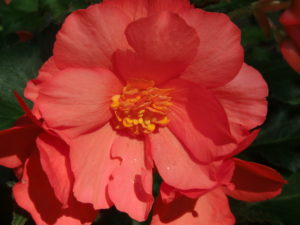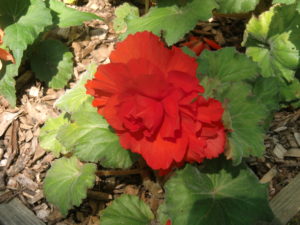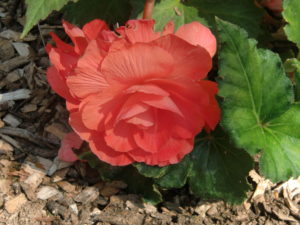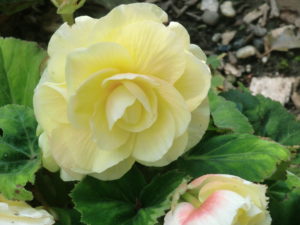Beautiful Plants For Your Interior
Tuberous Begonias

The Tuberous Begonias
I have been attempting to grow tuberous begonias now for several years and have had some success with them. They are very difficult to grow here on Long Island as our summers are right on the edge of being too hot for them. Let me explain their culture.
Obtaining plants: As their name suggests, they are usually started in the early spring from tubers, which are usually 1.5″ to 2.5″ in diameter. Many nurseries, both walk-in and mail order, sell them. Size is no indication of quality. In fact most high quality tubers (which can cost $75.00) are usually no larger that 1.5″. The tuber is strictly a storehouse of energy to bring the plant through its dormant period and to supply the energy to start the plant growing after the dormant period. When you are just starting out, I strongly suggest that you purchase inexpensive tubers so if you are not successful you won’t have much of a monetary loss.
There are two main sources of high quality tubers:
| Blackmore & Langdon Ltd Stanton Nurseries Pensford, Bristol, England BS39 4JL
Telephone: 011 1275 332300 |
White Flower Farm PO Box 50 Litchfield, Ct 06759-0050
1-800-503-9624 |
Blackmore & Langdon, a world renowned nursery, has fantastic tuberous begonias but some are quite expensive and there is a large charge for export documents and airmail and you must have a USDA plant import license. They also have inexpensive tubers, but the overhead costs are still high. White Flower Farm is a reseller for Blackmore & Langdon tubers in the USA. Their prices are very high too and I would only recommend either of them if you really know how to grow tuberous begonias and have a very deep pocket. Many mail order and large walk-in nurseries sell relatively inexpensive tubers in the late winter/early spring. These usually come from Holland and produce beautiful plants and these are the tubers you should start out with.
Starting the tubers: You should arrange to have the tubers arrive the last week of March. There is a top and bottom to the tubers. They are concave on the bottom and convex on the top. Usually, but not always, you will see one, two or three eyes appearing on the top of the tuber, not too different from eyes on a potato. Place the tuber in a small pot of high organic matter potting soil. There should be only 1 inch of space between the edge of the tuber and pot. If you have several tubers, they all can be placed in a seed flat leaving 1-1/2″ between tubers. Cover the tubers with 1/2 inch of soil and water sparingly. Over watering is a no-no. The tubers will produce roots on the top of the tuber too which is the reason to cover them with soil. They will probably not need additional water for 2 or 3 weeks after the initial watering. They should be left a warm place. No fertilizer is need at this time.
In about 2 weeks shoots will appear. They should then be placed in a location where there is bright light but no more that 3 hours of direct sunlight. Depending on your climate they could be placed outdoors, but here in the North East USA they should be left in a worm location. The appearance of the shoots indicates the roots are beginning to grow and now you will have to water and start to give water soluble fertilizer. I use Peters 20-20-20, 1 tablespoon per gallon of water once a week.
You will have to re-pot as the plant grows but don’t over-pot. You will probably never need a larger pot than 8″ and most of the time, a 6″ pot is sufficient. If you started the tubers in flats, you should re-flat them or pot them up at this juncture.
Growing on and flowers: The final growing area is very important. These plants were found in nature growing in cool mountainous areas where they had cool misty days, plenty of rain but with quick draining high organic matter soil. They were never sitting in sodden soil nor were they ever exposed to hot, dry sunlight. You must duplicate that as best as you can. They can take full sun for 2 or 3 hours but more than that is too much heat for them. They do need sunlight in order to bloom well with large flowers. Avoid a hot, full sun location though. High shade is very good and the soil should be amended with peat moss or compost to bring the organic matter up to at least 50% and it should drain quickly.
If you are growing in pots, I use Pro Mix or one of the Scott’s potting mixes. I add about a tablespoon of a slow release fertilizer, Ozmacote or a similar fertilizer. The trick is to have the plant grow but not too quickly as the outer skin on the stem gets too thin on fast growing begonias and can be attacked by stem rot. After the Ozmacote is used up, usually 2 or so months, a weak water soluble fertilizer can be used weekly. Again don’t force the plant to grow too quickly. You want to keep the plants on the dry side. Over watering is deadly!
The pots should be placed where it is not too windy, as they will become top-heavy as they grow and a wind can easily blow them over. Also, staking will be required. I place three or four 18″ stakes equi-distant around the edge of the pot when I do the final potting and tie two strings around all the stakes, one 6″ from the top of the pot and the other at the top of the stakes. This will contain the stems and prevent them from breaking off due to their weight.
I grow most of my plants in the ground in large beds. I grow too many plants to try to pot them all up and tend them over the summer. The sun exposure of the beds is important and as with the pots, a lot of sky light is great, but no more than 2 or 3 hours of direct sun light should be allowed. I plant around Mother’s Day, (May 30th in the USA) after any threat of frost is gone. Growing in a bed does have some problems. You can’t stop over watering if we have a very wet summer. Thus the bed must be will drained. Also, natural soil is loaded with fungus spores that will splash up onto the stems with heavy rain. Any break in the stem skin will allow the fungus to enter the plant and cause stem rot. I reduce this eventuality by putting a mulch on top of the soil after I plant. The mulch is very helpful. I plant the begonias on 12″ centers, adding a tablespoon of Ozmacote to the soil around the roots. As with the pot plants, I try to grow them slowly so as to keep the stem skin as thick as possible. I stake taller plants as needed and spray the plants with a fungicide once a week..
Blooming: The plants will begin to bloom usually in June, depending of when you started them and how cool it is outside. The experts remove the first flower buds on a plant, so to give the plant a chance to mature before blooming. I don’t do that for the simple reason that with so many plants, I can’t remember which plants are having their first flower. I just let them bloom.
Flowers: Tuberous begonias usually bloom with a cluster of 3 flowers; a male flower in the center and two female flowers, one on either side of the male flower. It is very easy to tell the flowers apart; the male flower is fully double, with many petals in the flower, much like a hybrid tea rose. The female flowers are single, with two petals and two sepals and a very large, winged ovary at the rear of the flower. The ovary can be an inch in diameter with three prominent wings. You won’t have any trouble identifying them. The female flowers usually don’t add to the beauty of the inflorescences and are usually removed as soon as possible. The flower will last two to three weeks and as it fades another will start to bloom giving you uninterrupted flowers all summer. The flowers can be 6″ to 7″ in diameter with very bright colors. The main flower colors are: white, pink, orange, red, orange/white or red/white picotee. All flower colors can have smooth edge petals or filigree edge petals.
In the autumn: Frost will kill the foliage and flowers immediately. When this happens, dig up the tuber, together with the clump of soil adhering to the roots. Place this in a cool, dark, dry area, don’t let it freeze. After a month or so the clump will be dried out and you can gently rub off the soil and most of the small roots. The tuber will have grown some since you planted it (if you can remember how large it was to begin with). The tuber should be hard, not soft and mushy. If it is soft, discard it. Store the tuber over the winter as you would dahlia roots or gladiola corms: a cool, dry spot and inspect them every month or so to be sure no insects are active. Next spring, start all over again.
Some fun, Propagation: You can have fun with tuberous begonias. Lets talk about propagation. Obviously if you paid a fortune for one tuber, it might occur to you that if you could have two or three plants from that one tuber, your cost per plant would go way down. Also, you might have gotten a “cheap” tuber that you really like and would like to have more of them or lastly, if you grow from seed (more about that later) you might find a seedling that is particularly good and want to propagate it.
There are two ways to asexually propagate tuberous begonias. The first way, which you should not do, is to cut the tuber up like a potato, leaving an eye on each piece. The begonia will not grow roots on the cut side of the tuber and thus you permanently handicap the tuber.
The other way is to root cuttings. This works quite well. The best cuttings are taken in the spring when the tuber is sprouting. Sometimes several eyes will start to grow from one tuber especially if it is large. When these are 3 or 4″ long protruding from the soil, you can break off extra sprouts (obviously leaving the most vigorous one alone). By wiggling them, you can break the stem where it is attached to the tuber. Just take the stem and put it in a pot with potting mix, keep it moist and humid with a lot of light, no direct sun light, and it will root in 2 or 3 weeks. I place the pot in a small plastic bag to keep the humidity up. Be sure that the bag gets no direct sunlight as it will heat up the bag and cutting inside it. As much indirect light as possible. No rooting hormone is necessary.
The other way to take cuttings is in the late summer. Just before frost, I take stem cuttings of desired plants. They are 3 to 4″ long. These are the terminal ends of the stems. Handle them the same as the spring cuttings, but you will have to have some way to keep them growing through the winter. I grow them under 24 hour lights in the basement, which works just fine. Again, a hormone is not necessary. I do this for seedlings as it is in the autumn that you can determine which seedlings produced the best flowers.
More fun, Seed growing: If you really want to have some fun, grow seed. You can purchase seed from Blackmore & Langdon. Get the seed delivered in January or February. Plant it in late February.
Now you will discover that the seed is about as fine as flour, almost as small as orchid seed. Snapdragon seed is enormous compared to this seed. It germinates quite easily but it must be handled very carefully. Pro Mix or the like works fine. Just sprinkle the seed on top of the soil mix, being sure to scatter the seed all over the surface. It is very easy to accidentally dump all the seed in one small area of the flat. There is no need to cover the seed with soil, just let it lie on the surface.
Never let the top of the soil dry out, but don’t have the soil sodden with water either. When the top of the soil needs water, I use a very fine spray. The seedlings will grow faster that you think and about 6 weeks after sowing they are ready to be pricked out and planted in flats on 1-1/4 inch centers again using the regular potting mix amended with Ozamote or the like.
By May 15th the seedlings will completely fill the flats and can either be transplanted into other flats on 3-inch centers, planted in pots or in the bed, which ever suits you. And away you go. You will be delighted when they start to bloom in July. Most will be wonderful, a few not so good. See below for seedling tuber handling at the end of the summer.
More fun, Lets talk about tubers: There are three growth phases in tuberous begonias: Vegetative Growth, Reproduction Growth and Tuber Growth. As the name implies, vegetative growth is the first phase of growing. It is the new shoot growing out of the tuber or the initial growth from the seed. This phase continues until the plant is about 5 or 6 inches high.
When the plant reaches this height, the next phase takes over and it starts to produce flower buds, which is of course the reproduction phase. (I’ll talk about seed formation later.) The tuberous begonia, like many plants, responds to the number of hours of daylight. When it senses that the days are getting shorter, the start of autumn, it starts to prepare itself for winter dormancy and it starts to spend all of its efforts to store nutrients in its tuber.
You won’t notice this as the plant keeps developing existing buds into flowers and existing flowers will remain. But bud formation will cease. Any frost will kill the top of the plant and it will immediately go into dormancy. So the longer that frost holds off, the larger the tubers will become. This is especially important for seedlings or spring cuttings, as they have started the season with no tuber. Generally, the tuber on a seedling or spring cutting is 5/8″ to 3/4″ when you dig up the now frost-killed plant. I have seen them as small as 1/4″.
These tiny tubers are not easy to bring through the entire winter dormant. Instead of waiting until March to start them, it is best to start them in late December or early January, just after they have dried out. That means you will have to have a greenhouse or use lights as I do. Now it might occur to you to dig up the plant, or move the pot, into a greenhouse before a frost and keep growing it all winter. That doesn’t seem to work well. The plant needs a dormant period. It only works well for late summer cuttings that you bring through the winter under lights or in a greenhouse. They will be quite large in the spring and thus will flower earlier than March started tubers. But they will not have a tuber formed until late summer. They can grow into very large plants and be unwieldy.
Growing under lights has one enormous advantage: you can control the day length. I always thought it would be a fun experiment to put some begonia seedlings under 8 hour lights in June and see if they would produce large tubers by October, in other words give them 4 months of short days. Never did it, too busy at that time of the year.
Most fun, make your own seed: The male (staminate) flower on the tuberous begonia is called a “double” flower. Instead of four petals (2 sepals and 2 petals) it has hundreds of petals, much as a hybrid tea rose. The word “double” is a misnomer as the petals haven’t doubled but rather are 50 times the quantity of original petals. Those extra petals are actually stamens that have turned into petals! This makes the flower especially beautiful, but it also removes all the pollen from the male flower and thus effectively prevents the plant from producing seed.
Fortunately, it was observed that during short days (autumn) that not all the stamens will become petals. If you take a male, fully double flower in the fall and carefully remove the petals you will find a few pollen baring stamens. You can then transfer the pollen onto the pistols of the female flower (which are very visible). It takes about 4 to 6 weeks for the seed capsule to ripen and open. There is a lot of seed! The seed can then be handled as instructed above. Good Luck
Another advantage of growing under lights is that you can create short days whenever you wish. If you move a budded plant in July from outside to under lights for less than 12 hours, the small buds that would normally mature to produce fully double flowers outside will produce male flowers with loads of pollen in September or October.. This will then give you seed in December or January, just when you would want to plant it. That new, fresh seed will germinate like crazy. Sum up: If you want a horticulturally worthwhile challenge, try tuberous begonias. They will reward you with spectacular flowers and hours of enjoyment
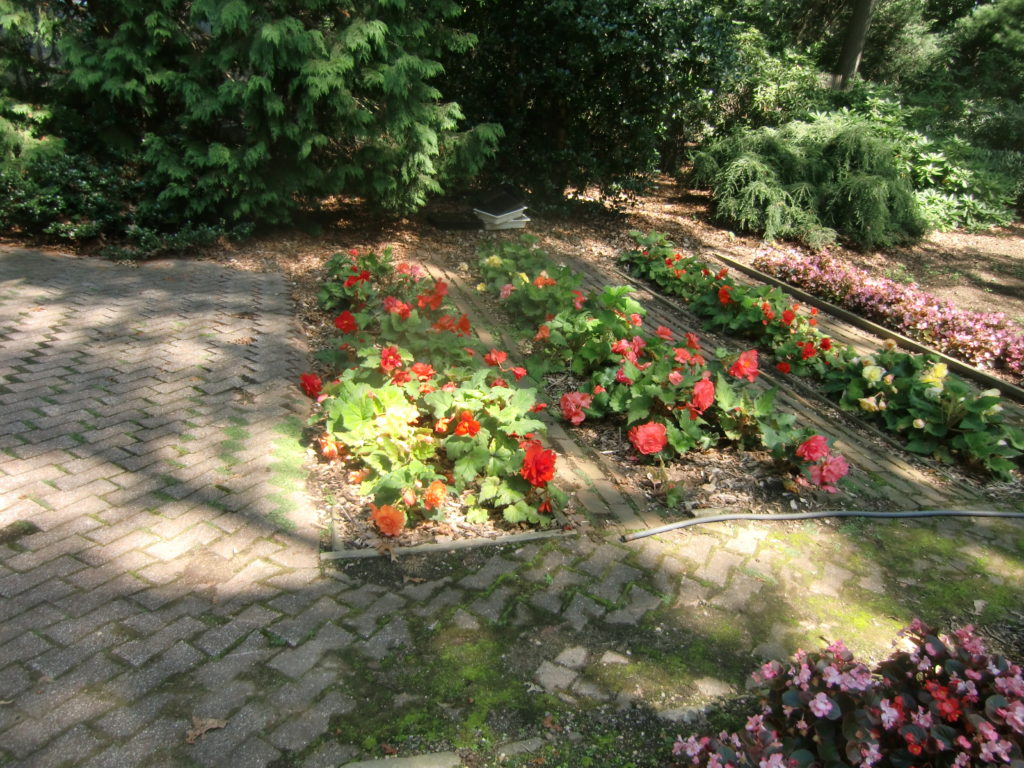
The following pictures are close up of some of the begonias grown from seed planted February, 2017. Pictures taken 8/14/17.
What you are looking for is a full double flower, much like a hybrid tea rose, large flowers that stand up from the foliage and looking at you. When you grow outdoors the rain will frequently pull the flowers down a little. Most of the colors are very intense. The flowers can easily be 6 or 7 inches in diameter. When you grow from seed you get a variety of flower types; some perfect and some not good. I have included a few pictures below so you can an idea of form of the flowers.
